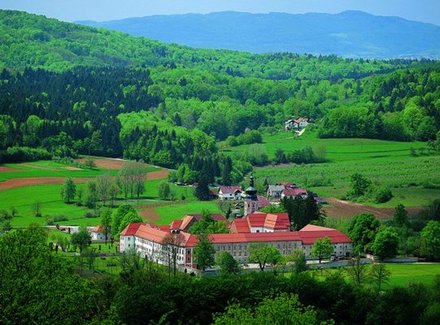
SloveniaHolidays.com > Kostanjevica na Krki > The Cistercian monastery
The Cistercian monastery
The Cistercian monastery - presentation
The Cistercian monastery community in Kostanjevica na Krki was founded by Bernard Spannheim in the 13th century. It was based in the monastery that is now called the Kostanjevica castle. Only the gothic Church of the Annunciation remains from the Middle Age architecture.
The former monastery with the largest arcade courtyard in Central Europe is now fortified with two renaissance oval towers and houses the gallery of Božidar Jakec.
Next to the monastery complex, there's a permanent outdoor exhibition of stone sculptures created at the Forma Viva international sculptor symposiums.
The courtyard of the extensive monastic complex is bordered on the northern side by the ruins of former monastic rooms and cloister, along with the main element of the former monastery, the order's church.
These are also the only parts of the original complex from the 13th century, when the Carinthian Duke Bernard Spanheim economically and strategically consolidated his possessions along the River Krka by constructing a sacral building. The church, which undoubtedly began to appear upon the founding of the monastery in 1234, was built as a three-nave basilica with a transverse nave and a pair of chapels along the square-ended presbytery, thus suiting the ideal of Cistercian architecture, what is termed the Bernardine architectural type.
The observer's attention is drawn primarily to the sheaf-like columns with capitals supporting the cross vaulting columns, complete with a wealth of carved vegetal motifs of buds, palms and wreaths. In the Baroque period the church, and along with it the entire monastery, underwent a comprehensive reconstruction.
Today it is the architectural elements that provide the fundamental component of this exceptional space, since with the dissolution of the monastery in 1786 the church lost its original sacral function, and later also all its furnishings.
Following extensive restoration and renovation works, the former monastery church acquired its present image in 1971, and as such represents one of the finest examples of late Gothic (later with a Baroque treatment) architecture in Slovenia.
Božidar Jakac Art Museum uses this space as an exhibition area, for which established Slovenian and foreign artists prepare site specific projects/temporary exhibitions that enjoy great attention from experts and the public alike.











